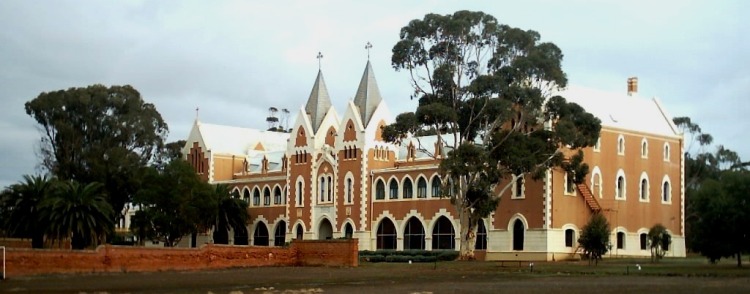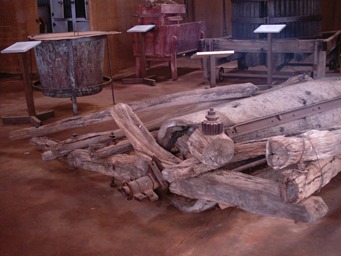
Australia So Much to See




New Norcia
My first visit to New Norcia was when I was three or four years old. With my parents and sister we taken on a guided tour of the magnificent buildings. New Norcia was running as a school at the time, and we and a few other tourists stood quietly in the back of a classroom of what were probably grade one or two children. The teacher welcomed the visitors and asked the class to sing a song “for the children”. My sister and I were the only children present. I was amazed and felt so honoured; they sung just for us.
Establishment
The monastery of New Norcia was established in 1847 by the Spanish Benedictine order. Bishop Rosendo Salvado spent 54 years making New Norcia one of the most progressive and successful missions in Australian history. Salvado’s vision was to create a Christian, largely self-sufficient village based on agriculture, educating the Aboriginal people in the Victoria Plains area. New Norcia was named after the town of Norcia in Italy, the birthplace of Saint Benedict.
The area was chosen for its farmlands to suit a diverse range of primary production. The monks grew wheat and milled it into flour to make bread. They planted olive groves and cold-pressed the fruit into extra virgin olive oil. They ran cattle, sheep and pigs and operated a butcher. They had orchards, and an apiary for honey. They grew vineyards and made quality wines.
A simple roller made mainly from logs for clearing the land. This would have been dragged by a team of horses.
Education
With a focus on education, the first Abbot of New Norcia, Rosendo Salvado, established the Aboriginal girls and boys schools which operated into the 1970s.
In 1901 of Salvado’s successor, Father (later Abbot and Bishop) Fulgentius Torres, finding the Mission in decline, sold land to raise development funds. He personally designed and supervised the building of St Gertrude’s Ladies College (opened 1908), and St Ildephonsus’ College for Boys (opened 1913). In his fourteen years as Abbot, Torres carried out significant improvements throughout the town. He paid particular attention to the interior decoration of the town’s buildings, bringing the Spanish woodcarver Juan Casellas and the monk-artist Father Lesmes Lopez to New Norcia to create the many fine works that are now part of its rich heritage.
The European girls and boys boarding schools commenced in 1970 as New Norcia Catholic College which closed in 1991.
These former College buildings are now used for school and music camps, adult workshops, and conventions. In 1996 the monks established an Education Centre which offers schools a range of programs, including Aboriginal studies.
Farming
and self sufficiency
New Norcia’s traditional crafts of self sufficiency, bread making and olive oil production have also been revived.
After generations of grape-growing and winemaking, the monks of New Norcia sold their vineyard in nearby Wyening in the 1970s. In the mid-1990s, local Bindoon Estate wine producer Nick Humphry approached the monks with the idea of selling his wine uniquely in New Norcia and under a Benedictine label. In 2000, the first wines of what is now known as New Norcia Abbey Wines, were produced and sold only within the confines of the town.
While this new generation of monks lacks the manpower to maintain Rosendo Salvado’s goal of complete self-sufficiency, they still cultivate all areas of the town, including areas of its agriculture, with the help of about 50 employed laypeople.
Peter Grainger, as the farm manager, is responsible for 8,350 hectares of farmland, including some 3,000 hectares of crops (wheat, lupins, canola and oats); 7000 merino sheep. Peter Grainger has also taken over the olive groves which were tended by the old town baker, Dom Paulino, until his death in 2010. “Dom Paulino used to tend the groves on a quad bike,” says Peter. “He was involved in the whole production with the ancient cold-press method in the old olive workshop.”
What can you see?
Today the Benedictine Community operates several businesses to cater for visitors to New Norcia.
The Museum and Art Gallery has many fine displays of art works. Established on its present site by Abbot Bernard Rooney in 1978, the Museum and Art Gallery was formerly St Joseph’s Aboriginal Girls’ Orphanage.
Outstanding buildings include the Monastery (originally built in 1847) the Abbey Church built from local stone and timber (with additions since its opening in 1861), St Gertrude’s (1908), St Ildephonsus’ (1913), and the Hotel (1927). The orphanages of St Mary and St Joseph are also architectural beauties.
Exhibitions include:
St Joseph’s Aboriginal Girls’ Exhibition
Through first-hand accounts of past students, video clips, display boards and artefacts, the St Joseph’s Aboriginal Girls’ Exhibition reflects the experiences of Aboriginal girls resident at the Orphanage at New Norcia.
Gardner Botanical Exhibition
The Gardner Botanical Exhibition features botanical artworks on paper – all of Western Australian plants – by Western Australia’s first Government botanist, Charles A Gardner.
The European Art Gallery
This displays principally post renaissance Italian and Spanish works. New Norcia’s founder, Bishop Rosendo Salvado, selected paintings during trips to Europe, with others chosen for him by agents. There is some exceptional works of art here, like you would expect to visit a European Gallery to find.
Australian Contemporary Gallery
Since 1986, the community has collected well over 100 modern artworks on religious themes including paintings, sculpture and craft.
The Blacksmith’s Workshop houses early farming equipment, mostly made locally with ingenuity. This building was closed during recent restoration.
You can take a Heritage Walk of the old buildings.
A short River Walk through key farming features can be also followed from
this brochure
Where to stay
The Roadhouse, including a General Store, also serves as a Post Office and provides an overnight stay area for campers and caravanners. There are eight powered sites and self sufficient caravanners can camp down near the oval area.
The New Norcia Hotel provides accommodation, meals and licensed bar services to visitors. Originally built as a hostel for visiting parents it was converted to a hotel in the 1950s.
The above article was compiled using New Norcia as a reference for facts and dates.
Our visit to New Norcia in 2003 predates most of my digital photography, so photos here are few. There is something of interest for everyone at New Norcia.